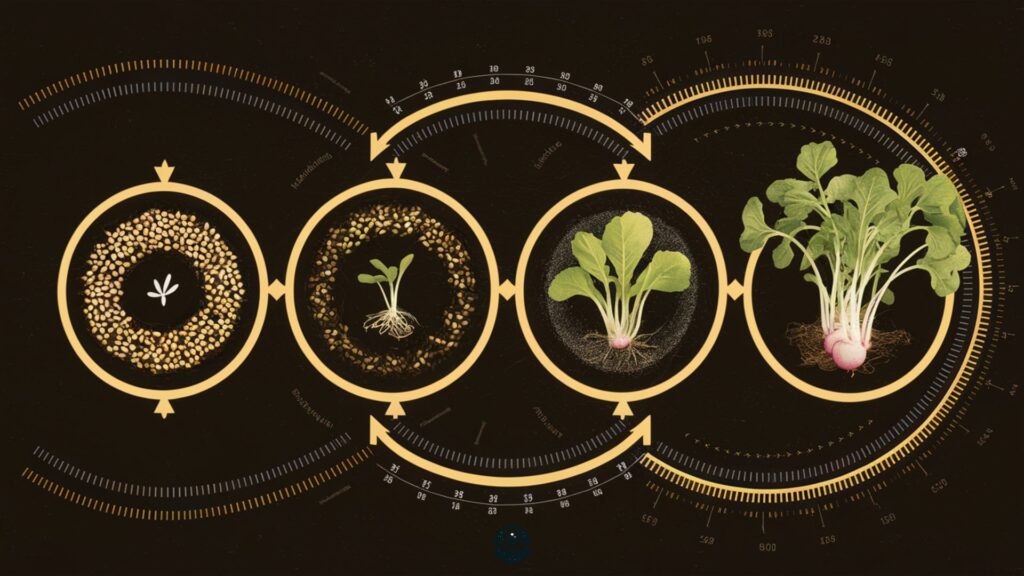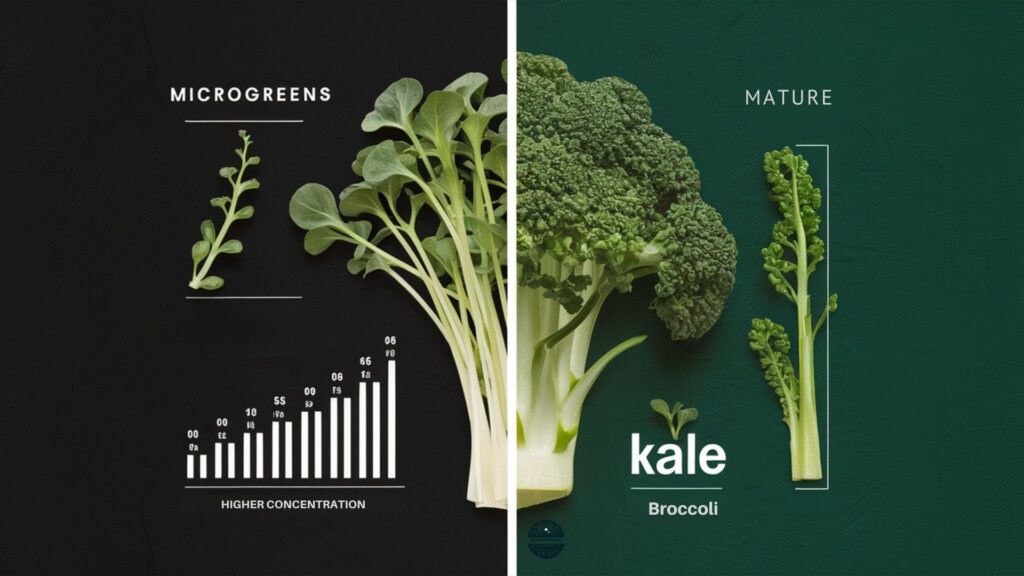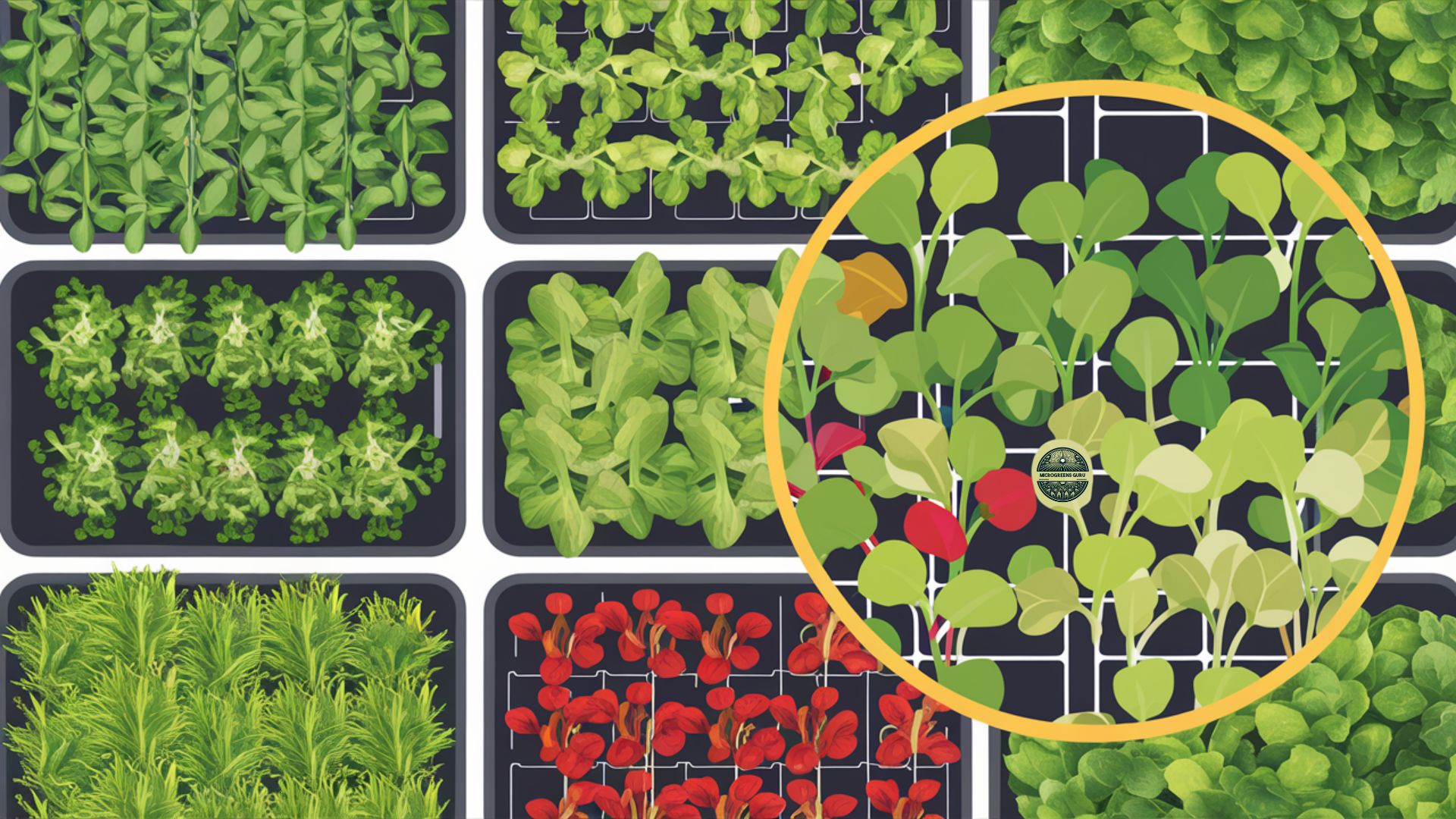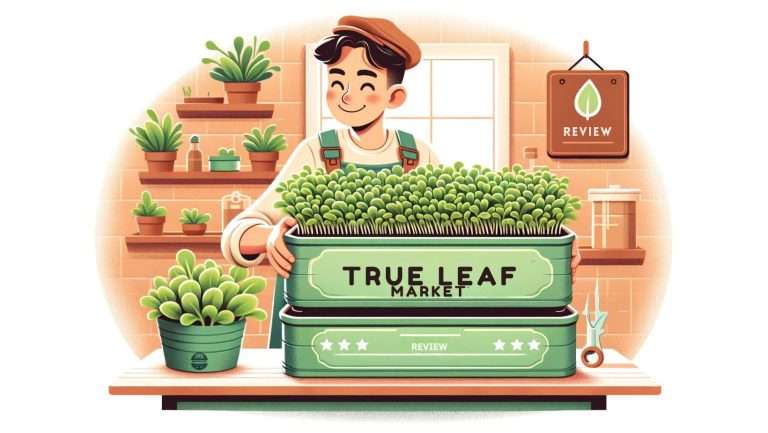Microgreens Unveiled: The Tiny Superheroes Taking Over Your Plate
Some of our posts on Microgreensguru.com contain affiliate links. If you click on an affiliate link and make a purchase, we may receive a commission. Clicking on an affiliate link that earns a commission does NOT result in additional charges or costs you extra. Earnings from affiliate links help keep this website running. See our full affiliate disclosure here.
As a microgreens enthusiast, grower, and educator, I’ve spent the last five years immersed in the world of these tiny, nutrient-packed powerhouses. What started as a personal quest for better health has blossomed into a thriving business and educational platform.
Today, I’m excited to share my knowledge and passion with you, unveiling the secrets of microgreens and why they’re taking the culinary world by storm.

What Are Microgreens?
Imagine a plant in its infancy, just a week or two old, standing barely an inch tall. That’s a microgreen for you. These young seedlings of vegetables and herbs are harvested shortly after they’ve sprouted their first set of true leaves. Don’t confuse them with sprouts, though – microgreens are a bit older and are grown in soil or other growing mediums, not just in water, like sprouts.
Microgreens burst onto the culinary scene in the 1980s, making their debut in California restaurants. Chefs fell in love with their vibrant colors, intense flavors, and delicate textures. But it wasn’t until 1992 that the term “microgreens” was coined, and these tiny greens began their journey to becoming a global food trend.
Microgreens at a Glance
Nutrient-Rich
Up to 40 times more nutrients than mature plants
Easy to Grow
Can be grown at home with minimal equipment
Versatile
Over 25 varieties with unique flavors and textures
Quick Harvest
Ready to eat in 7-14 days after planting
Types of Microgreens: A Rainbow of Flavors
In my years of growing and experimenting, I’ve worked with a wide variety of microgreens. Some of my favorites include:
- Broccoli microgreens: Packed with sulforaphane, they offer a mild, peppery flavor.
- Radish microgreens: Spicy and crisp, perfect for adding a kick to salads.
- Sunflower microgreens: Nutty and slightly sweet, these are a crowd-pleaser.
- Pea shoots: Tender and sweet, they taste like spring in every bite.
- Amaranth microgreens: Earthy and slightly sweet, with stunning red or green leaves.
Each variety brings its unique flavor profile to the table. Arugula microgreens offer a peppery punch, while cilantro microgreens provide a citrusy zing. The world of microgreens is vast, with over 25 different types available, each offering a new adventure for your taste buds.
Interactive Microgreens Comparison
| Microgreen Type | Growth Time (Days) | Flavor Profile | Nutrient Density Score | Best Uses |
|---|---|---|---|---|
| Broccoli | 7-10 | Mild, slightly spicy | 8.5 | Salads, sandwiches |
| Broccoli microgreens are rich in sulforaphane, a compound known for its potential cancer-fighting properties. They’re easy to grow and highly versatile in the kitchen. | ||||
| Radish | 5-7 | Spicy, peppery | 7.8 | Garnish, stir-fries |
| Radish microgreens grow quickly and offer a spicy kick to dishes. They’re packed with vitamins C and E, making them a great immune-boosting addition to meals. | ||||
| Sunflower | 8-12 | Nutty, slightly sweet | 9.0 | Salads, smoothies |
| Sunflower microgreens are loved for their nutty flavor and crunchy texture. They’re an excellent source of protein and healthy fats, making them a favorite among vegetarians and vegans. | ||||
| Pea Shoots | 10-14 | Sweet, pea-like | 8.2 | Stir-fries, garnish |
| Pea shoots are tender and sweet, tasting like a concentrated version of fresh peas. They’re rich in vitamins A and C, and add a lovely texture to various dishes. | ||||
| Amaranth | 8-12 | Earthy, slightly sweet | 8.7 | Salads, garnish |
| Amaranth microgreens are known for their vibrant red color and high protein content. They’re also rich in calcium and iron, making them a nutritional powerhouse. | ||||
Nutritional Powerhouses: Tiny Greens, Big Benefits
One of the most exciting aspects of microgreens is their nutritional density. These little guys pack a serious punch when it comes to vitamins, minerals, and antioxidants. In fact, research has shown that microgreens can contain up to 40 times more nutrients than their fully-grown counterparts.

For example, red cabbage microgreens have 40 times more vitamin E and 6 times more vitamin C than mature red cabbage. Cilantro microgreens contain three times more beta-carotene than mature cilantro. It’s like nature’s multivitamin, served fresh on your plate!
But the benefits don’t stop there. Microgreens are rich in polyphenols, which are powerful antioxidants that may help prevent various diseases. Some studies suggest that regularly consuming microgreens could help manage diabetes, reduce the risk of certain cancers, and support heart health. While more research is needed, the potential health benefits are promising.
Growing Microgreens at Home: Your Personal Green Factory
One of the best things about microgreens is how easy they are to grow at home. Trust me, I started my journey with just a few trays on my windowsill! Here’s a simple guide to get you started:
- Choose your seeds: Start with easy-to-grow varieties like broccoli, radish, or sunflower.
- Prepare your growing tray: Use a shallow tray filled with a good-quality potting mix or coconut coir.
- Sow your seeds: Sprinkle them evenly over the surface and gently press them into the soil.
- Cover and wait: Use a clear lid or plastic wrap to create a mini greenhouse effect. Most seeds will germinate in 2-3 days.
- Uncover and grow: Once sprouted, remove the cover and place the tray in a spot with good indirect light.
- Water gently: Use a spray bottle to keep the soil moist but not waterlogged.
- Harvest: When the first true leaves appear (usually 7-14 days after planting), snip the microgreens just above the soil line.
- Handle with care: After harvesting, handle your microgreens gently to avoid bruising. Use clean, dry hands or sanitized scissors and avoid crushing or compressing the delicate leaves.
- Store properly: If not using immediately, store your freshly harvested microgreens in a clean, airtight container lined with a slightly damp paper towel. Place the container in the refrigerator, where they can stay fresh for 5-7 days. Remember, the sooner you eat them, the more nutrients you’ll get!
The beauty of growing microgreens is that you can have a constant supply. I usually start a new tray every week, ensuring a steady harvest for my kitchen experiments. And, with proper handling and storage, you can enjoy your homegrown microgreens at their peak freshness for days after harvest.
A quick tip from my experience: if you notice any yellowing or wilting during storage, it’s best to use those microgreens right away. They’re still perfectly good to eat, but their nutritional value and flavor start to decline once these signs appear.
Microgreens: A Journey Through Time
1980s
Microgreens begin appearing on chefs’ menus in California, gaining popularity among high-end restaurants.
1992
Craig Hartman invents and coins the term “Microgreens” when his friend Michael Clark grows and delivers what he believed were baby greens. Pam Parseghian, a food writer from Nations Restaurant News, publishes a story about microgreens, sharing it with restaurant professionals across America.
1990s
Microgreens become increasingly popular among high-end chefs as a way to add color and flavor to dishes.
2000s onwards
Microgreens gain wider recognition and popularity. They become available at farmers’ markets and specialty food stores. Increased interest in local food movements contributes to their popularity. Research shows microgreens can contain up to 40 times more nutrients than their fully-grown counterparts.
2010s-Present
Microgreens become a staple in many restaurants. Growing popularity among home gardeners and health-conscious consumers. Increasing research into their nutritional benefits and cultivation methods. Projected growth of the global microgreens market from $1.3 billion in 2019 to $2.2 billion by 2028.
Culinary Applications: Elevating Your Meals
Microgreens are incredibly versatile in the kitchen. Their intense flavors and vibrant colors can elevate even the simplest dishes. Here are some of my favorite ways to use them:
- As a garnish: Sprinkle them over soups, salads, or main dishes for a pop of color and flavor.
- In sandwiches and wraps: Add a handful for extra crunch and nutrition.
- In smoothies: Boost your morning smoothie with a nutrient kick.
- As a bed for grilled meats or fish: Create a beautiful presentation while adding flavor.
- In pesto: Replace some of the basil with microgreens for a unique twist.
One of my go-to recipes is a microgreen pesto pasta. I blend sunflower microgreens with basil, garlic, pine nuts, and olive oil for a nutrient-dense sauce that’s bursting with flavor. It’s always a hit at dinner parties!
The Microgreens Industry: A Growing Trend
The microgreens market has seen substantial growth in recent years. From high-end restaurants to local farmers’ markets, these tiny greens are making a big impact. The global microgreens market was valued at $1.3 billion in 2019 and is projected to reach $2.2 billion by 2028.
This growth is driven by increasing awareness of the health benefits of microgreens, as well as a growing interest in sustainable, local food production. Microgreens tick many boxes for environmentally conscious consumers – they require minimal water, can be grown year-round in controlled environments, and have a low carbon footprint due to their short growing cycle and ability to be produced locally.
Frequently Asked Questions About Microgreens
As someone who’s been in the microgreens game for a while, I often get asked a lot of questions. Here are some of the most common ones:
Q: Are microgreens the same as sprouts? A: No, they’re different. Sprouts are germinated seeds grown in water, while microgreens are young seedlings grown in soil or other growing mediums and harvested after they develop their first true leaves.
Q: How long do microgreens last after harvesting? A: With proper storage (in an airtight container in the refrigerator), most microgreens can last 5-7 days. However, they’re best consumed as fresh as possible for optimal flavor and nutrition.
Q: Can I regrow microgreens after cutting? A: Generally, no. Most microgreens are harvested by cutting them at the base, which doesn’t allow for regrowth. However, some varieties like pea shoots can be cut above the lowest leaf node for a second (though smaller) harvest.
Q: Are microgreens safe to eat raw? A: Yes, microgreens are typically consumed raw to preserve their nutritional value and delicate texture. However, always ensure they’re grown in clean conditions and washed before consuming.
Q: How much should I eat to get the benefits? A: While there’s no set recommended amount, incorporating a handful of microgreens into your daily diet can provide a significant nutrient boost. Even a small amount can make a difference!
Key Takeaways: What I’ve Learned on My Microgreens Journey
After years of growing, eating, and breathing microgreens, here are the nuggets of wisdom I’ve picked up along the way:
- Microgreens aren’t just a fancy garnish – they’re nutrition powerhouses in disguise. I’ve seen broccoli microgreens pack up to 40 times more nutrients than their full-grown cousins. Talk about small but mighty!
- Don’t let their size fool you – microgreens are flavor bombs. I’ve turned many a bland salad into a taste adventure with just a handful of spicy radish or zesty cilantro microgreens.
- Growing microgreens at home is easier than you might think. Trust me, if I can do it, anyone can. All you need is a sunny windowsill, some seeds, and a bit of patience.
- Variety is the spice of life, and microgreens offer it in abundance. I’ve experimented with over 25 types, and each one brings something unique to the table. My current favorite? Sunflower microgreens – they’re nutty, crunchy, and absolutely delicious.
- Freshness matters. I’ve found that microgreens taste best and offer the most nutritional bang for your buck when they’re freshly harvested. That’s why I always encourage people to try growing their own.
- Microgreens aren’t just good for you – they’re good for the planet too. They use less water than traditional crops and can be grown year-round, even in small urban spaces. It’s a win-win!
- The microgreens market is booming, and for good reason. More people are waking up to the benefits of these tiny greens. Who knows? Your microgreens hobby today could turn into a thriving business tomorrow.
- Continuous harvests are the secret to always having fresh microgreens on hand. I start a new tray every week, ensuring I never run out of these nutritious little guys.
Remember, your microgreens journey is just that – yours. Don’t be afraid to experiment, make mistakes, and find what works best for you. And most importantly, have fun with it! After all, playing with your food is encouraged when it comes to microgreens.
Essential Tools for Your Microgreens Adventure
As you embark on your microgreens journey, here are some products that I’ve found incredibly helpful:
- Microgreens Growing Kit: This all-in-one kit includes trays, growing medium, and a variety of seeds to get you started. It’s perfect for beginners and makes a great gift for the health-conscious foodie in your life.
- LED Grow Light: While not necessary if you have a sunny windowsill, a good grow light can significantly boost your yields and allow you to grow microgreens year-round, regardless of the weather outside.
- Organic Microgreens Seed Mix: This blend of organic seeds includes popular varieties like broccoli, radish, and kale. It’s a great way to experiment with different flavors and textures.
- Fine Mist Spray Bottle: Proper watering is crucial for microgreens, and a fine mist spray bottle helps you water gently without disturbing the delicate seedlings.
- Microgreens Scissors: These small, sharp scissors make harvesting your microgreens a breeze, ensuring clean cuts and minimal damage to the delicate greens.
Remember, while these products can enhance your microgreen growing experience, the most important ingredients are patience, care, and enthusiasm!
Final Thoughts: The Mighty Impact of Micro Greens
As we wrap up our journey through the world of microgreens, I hope you’re as excited about these tiny nutritional powerhouses as I am. From their humble beginnings in California kitchens to their current status as a global food trend, microgreens have proven themselves to be more than just a passing fad. They’re a sustainable, nutrient-dense, and versatile addition to our diets that can truly transform the way we eat and think about food.
We’ve explored what microgreens are, delved into their impressive nutritional profile, and discovered how easy they are to grow at home. We’ve also looked at their culinary applications, industry trends, and even tackled some common questions. Whether you’re a health enthusiast, a culinary adventurer, or just someone looking to add more nutrients to your diet, microgreens have something to offer.
But your microgreens journey doesn’t have to end here. In fact, this is just the beginning! I’d love to hear about your experiences with microgreens. Have you tried growing them before? Did you find it challenging or easier than expected? Maybe you’ve incorporated microgreens into your cooking and have a favorite recipe to share. Or perhaps you’re still unsure about where to start and have some questions.
Microgreens Knowledge Quiz
Whatever your thoughts or experiences, I encourage you to leave a comment below. Your insights could be incredibly valuable to others who are just starting their microgreens adventure. And if you’ve found this article helpful, why not share it with friends or family who might also be interested in exploring the world of microgreens?
Remember, at Microgreens Guru, we’re here to support you every step of the way. If you have any questions about the content of this article or need further guidance on your microgreens journey, don’t hesitate to reach out. You can contact us through our website or leave a comment below, and we’ll be more than happy to help.
Microgreens may be small, but their impact on our health and culinary experiences can be enormous.
So why not give them a try?
Start small with a single tray on your windowsill, or look for them at your local farmers’ market. You might just find yourself, like me, falling in love with these tiny superheroes of the plant world.
Now, I’d love to hear from you:
- What was your biggest takeaway from this article?
- Have you tried growing or eating microgreens before? If so, what was your experience?
- What challenges do you anticipate in starting your microgreens journey?
- Are there any specific microgreen varieties you’re excited to try?
- How do you plan to incorporate microgreens into your diet?
Your feedback and questions are not only welcome but essential in helping us create more valuable content and resources for our microgreens community. So, please, share your thoughts in the comments section below. Let’s continue this conversation and grow together in our appreciation and knowledge of microgreens!
Remember, in the world of microgreens, good things really do come in small packages.
Further Reading
If you’re hungry for more information about microgreens, I’ve handpicked some articles that dive deeper into various aspects of these tiny nutritional powerhouses:
- Best Soil to Use for Microgreens: Achieving Lush, Nutrient-Rich Harvests This article explores the ideal growing medium for microgreens, which is crucial for achieving healthy and nutrient-dense harvests.
- Growing Microgreens in an Apartment: Maximizing Space for Healthy Homegrown Goodness Perfect for urban dwellers, this guide shows you how to grow microgreens even in limited spaces.
- Can You Eat Too Many Microgreens? Expert Insight into Quantity and Health Impacts This article addresses a common concern about microgreen consumption and provides expert advice on optimal intake.
- Microgreens for Diabetes: The Ultimate Weapon in Your Diabetes Battle Explore how microgreens can be a powerful tool in managing diabetes and improving overall health.
- Types of Microgreens: The Definitive Guide to Growing, Harvesting, and Enjoying This comprehensive guide delves into the various types of microgreens, their unique characteristics, and how to grow and enjoy them.
Bonus: For those who want a comprehensive introduction to the world of microgreens, we’ve got you covered:
- Introduction to Microgreens: Your Complete Guide to Getting Started This in-depth resource is perfect for beginners and enthusiasts alike. It covers everything you need to know about microgreens, from basic definitions to advanced growing techniques and nutritional information. Whether you’re just curious or ready to start your microgreens journey, this guide will provide you with a solid foundation of knowledge.
These resources offer a wealth of information to deepen your understanding of microgreens, from cultivation techniques to health benefits. Whether you’re a beginner just starting out or an experienced grower looking to expand your knowledge, these articles provide valuable insights to support your microgreens journey. Happy reading and growing!

Cal Hewitt is the Founder and Lead Cultivator at Microgreens Guru, a website dedicated to empowering individuals to grow, consume, and potentially sell nutrient-dense microgreens. With 5 years of hands-on experience in microgreens cultivation, Cal brings a unique analytical perspective to the world of urban agriculture. He specializes in optimizing growth techniques for various microgreen varieties, while also focusing on sustainable and cost-effective growing methods. Cal’s passion for microgreens, ignited by a personal health journey, drives him to continuously explore and share innovative approaches to microgreens cultivation. His practical experience, combined with his commitment to education through his website and upcoming book, ensures that Microgreens Guru remains a valuable resource for both novice and experienced growers alike.







